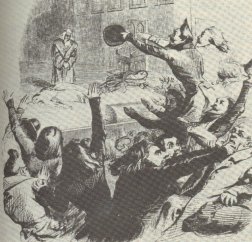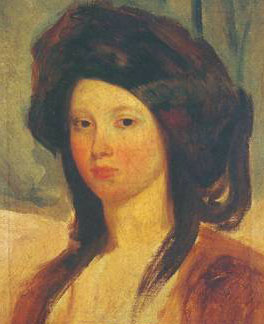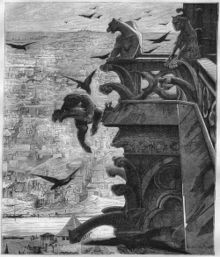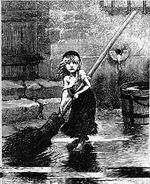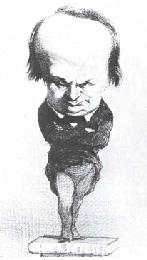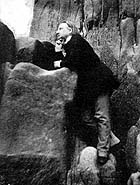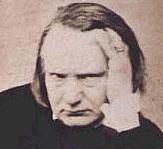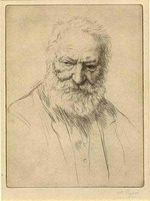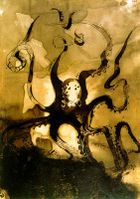Victor Hugo
2007 Schools Wikipedia Selection. Related subjects: Writers and critics
| Victor Marie Hugo | |
|---|---|
|
photogravure, 1883
|
|
| Born | 26 February 1802 Besançon, France |
| Died | 22 May 1885 Paris, France |
Victor-Marie Hugo ( 26 February 1802 – 22 May 1885) was a French poet, novelist, playwright, essayist, visual artist, statesman and human rights campaigner, recognized as the most influential Realist writer of the 19th century. His best-known works are the novels Les Misérables and Notre-Dame de Paris (movie:The Hunchback of Notre-Dame). Among many volumes of poetry, Les Contemplations and La Légende des siècles stand particularly high in critical esteem, and Hugo is sometimes identified as the greatest French poet.
Though extremely conservative in his youth, Hugo moved to the political left as the decades passed; he became a passionate supporter of republicanism, and his work touches upon most of the political and social issues and artistic trends of his time.
Early life and influences
Victor Hugo was the oldest son of Joseph Léopold Sigisbert Hugo (1773–1828) and Sophie Trébuchet (1772-1821). He was born in 1802 in Besançon (in the region of Franche-Comté) and lived in France for the majority of his life. However, he was forced into exile during the reign of Napoleon III — he lived briefly in Brussels during 1851; in Jersey from 1852 to 1855; and in Guernsey from 1855 to 1870 and again in 1872-1873. There was a general amnesty in 1859; after that, his exile was by choice.
Hugo's early childhood was great. The century prior to his birth saw the overthrow of the Bourbon Dynasty in the French Revolution, the rise and fall of the First Republic, and the rise of the First French Empire and dictatorship under Napoleon Bonaparte. Napoleon was proclaimed Emperor two years after Hugo's birth, and the Bourbon Monarchy was restored before his eighteenth birthday. The opposing political and religious views of Hugo's parents reflected the forces that would battle for supremacy in France throughout his life: Hugo's father was a high-ranking officer in Napoleon's army, an atheist republican who considered Napoleon a hero; his mother was a staunch Catholic Royalist who is believed to have taken as her lover General Victor Lahorie, who was executed in 1812 for plotting against Napoleon.
Sophie followed her husband to posts in Italy (where Léopold served as a governor of a province near Naples) and Spain (where he took charge of three Spanish provinces). Weary of the constant moving required by military life, and at odds with her unfaithful husband, Sophie separated temporarily from Léopold in 1803 and settled in Paris. Thereafter she dominated Hugo's education and upbringing. As a result, Hugo's early work in poetry and fiction reflect a passionate devotion to both King and Faith. It was only later, during the events leading up to France's 1848 Revolution, that he would begin to rebel against his Catholic Royalist education and instead champion Republicanism and Freethought.
Early poetry and fiction
Like many young writers of his generation, Hugo was profoundly influenced by François-René de Chateaubriand, the founder of Romanticism and France’s preeminent literary figure during the early 1800s. In his youth, Hugo resolved to be “Chateaubriand or nothing,” and his life would come to parallel that of his predecessor’s in many ways. Like Chateaubriand, Hugo would further the cause of Romanticism, become involved in politics as a champion of Republicanism, and be forced into exile due to his political stances.
The precocious passion and eloquence of Hugo's early work brought success and fame at an early age. His first collection of poetry ( Nouvelles Odes et Poésies Diverses) was published in 1824, when Hugo was only twenty two years old, and earned him a royal pension from Louis XVIII. Though the poems were admired for their spontaneous fervor and fluency, it was the collection that followed two years later in 1826 ( Odes et Ballades) that revealed Hugo to be a great poet, a natural master of lyric and creative song.
Against his mother's wishes, young Victor fell in love and became secretly engaged to his childhood friend Adèle Foucher (1803-1868). Unusually close to his mother, it was only after her death in 1821 that he felt free to marry Adèle (in 1822). They had their first child Léopold in 1823, but the boy died in infancy. Hugo's other children were Léopoldine ( August 28, 1824), Charles ( November 4, 1826), François-Victor ( October 28, 1828) and Adèle ( August 24, 1830). Hugo published his first novel the following year ( Han d'Islande, 1823), and his second three years later ( Bug-Jargal, 1826). Between 1829 and 1840 he would publish five more volumes of poetry ( Les Orientales, 1829; Les Feuilles d'automne, 1831; Les Chants du crépuscule, 1835; Les Voix intérieures, 1837; and Les Rayons et les ombres, 1840), cementing his reputation as one of the greatest eligiac and lyric poets of his time.
Theatrical work
Hugo did not achieve such quick success with his works for the stage. In 1827, he published the never-staged verse drama Cromwell, which became more famous for the author's preface than its own worth (the play's unwieldy length was considered "unfit for acting"). In his introduction to the work, Hugo urged his fellow artists to free themselves from the restrictions imposed by the French classical style of theatre, and thus sparked a fierce debate between French Classicism and Romanticism that would rage for many years. Cromwell was followed in 1828 by the disastrous Amy Robsart, an experimental play from his youth based on the Walter Scott novel Kenilworth, which was produced under the name of his brother-in-law Paul Foucher and managed to survive only one performance before a less-than-appreciative audience.
The first play of Hugo's to be accepted for production under his own name was Marion de Lorme. Though initially banned by the censors for its unflattering portrayal of the French monarchy, it was eventually allowed to premiere uncensored in 1829, but without success. However, the play that Hugo produced the following year— Hernani—would prove to be one of the most successful and groundbreaking events of nineteenth-century French theatre, the opening night of which became known as the "The Battle of Hernani". Today the work is largely forgotten, except as the basis for the Verdi opera of the same name. However, at the time, performances of the work sparked near-riots between opposing camps of French letters and society: Romantics vs. Classicists, Liberals vs. Conformists, and Republicans vs. Royalists. The play was largely condemned by the press, but played to full houses night after night, and all but crowned Hugo as the preeminent leader of French Romanticism. It also signalled that Hugo's concept of Romanticism was growing increasingly politicized: Hugo believed that just as Liberalism in politics would free the country from the tyranny of monarchy and dictatorship, Romanticism would liberate the arts from the constraints of Classicism.
In 1832 Hugo followed the success of Hernani with Le roi s'amuse (The King Takes His Amusement). The play was promptly banned by the censors after only one performance, due to its overt mockery of the French nobility, but then went on to be very popular in printed form. Incensed by the ban, Hugo wrote his next play, Lucréce Borgia (see: Lucrezia Borgia), in only fourteen days. It subsequently appeared on the stage in 1833, to great success. Mademoiselle George (former mistress of Napoleon) was cast in the main role, and an actress named Juliette Drouet played a subordinate part. However, Drouet would go on to play a major role in Hugo’s personal life, becoming his life-long mistress and muse. While Hugo had many romantic escapades throughout his life, Drouet was recognized even by his wife to have a unique relationship with the writer, and was treated almost as family. In Hugo’s next play ( Marie Tudor, 1833), Drouet played Lady Jane Grey to George’s Queen Mary. However, she was not considered adequate to the role, and was replaced by another actress after opening night. It would be her last role on the French stage; thereafter she devoted her life to Hugo. Supported by a small pension, she became his unpaid secretary and travelling companion for the next fifty years.
Hugo’s Angelo (play) premiered in 1835, to great success. Soon after, the Duke of Orleans (brother of King Louis-Philippe, and an admirer of Hugo’s work) founded a new theatre to support new plays. Théâtre de la Renaissance opened in November 1838, with the premiere of Ruy Blas. Though considered by many to be Hugo’s best drama, at the time it met with only average success. Hugo did not produce another play until 1843. The Burgraves played for only 33 nights, losing audiences to a competing drama, and it would be his last work written for the theatre. Though he would later write the short verse drama Torquemada in 1869, it was not published until a few years before his death in 1882, and was never intended for the stage. However, Hugo's interest in the theatre continued, and in 1864, he published a well-received essay on William Shakespeare, whose style he tried to emulate in his own dramas.
Mature fiction
Victor Hugo's first mature work of fiction appeared in 1829, and reflected the acute social conscience that would infuse his later work. Le Dernier jour d'un condamné ( Last Days of a Condemned Man) would have a profound influence on later writers such as Albert Camus, Charles Dickens, and Fyodor Dostoevsky. Claude Gueux, a documentary short story about a real-life murderer who had been executed in France, appeared in 1834, and was later considered by Hugo himself to be a precursor to his great work on social injustice, Les Misérables. But Hugo’s first full-length novel would be the enormously successful Notre-Dame de Paris ( The Hunchback of Notre Dame), which was published in 1831 and quickly translated into other languages across Europe. One of the effects of the novel was to shame the City of Paris to undertake a restoration of the much-neglected Cathedral of Notre Dame, which was now attracting thousands of tourists who had read the popular novel. The book also inspired a renewed appreciation for pre-renaissance buildings, which thereafter began to be actively preserved.
Hugo began planning a major novel about social misery and injustice as early as the 1830s, but it would take a full 17 years for his most enduringly popular work, Les Misérables, to be realized and finally published in 1862. The author was acutely aware of the quality of the novel and publication of the work went to the highest bidder. The Belgian publishing house Lacroix and Verboeckhoven undertook a marketing campaign unusual for the time, issuing press releases about the work a full six months before the launch. It also initially published only the first part of the novel (“Fantine”), which was launched simultaneously in major cities. Installments of the book sold out within hours, and had enormous impact on French society. Response ranged from wild enthusiasm to intense condemnation, but the issues highlighted in Les Misérables were soon on the agenda of the French National Assembly. Today the novel is considered a literary masterpiece, adapted for cinema, television and musical stage to an extent equaled by few other works of literature.
Hugo turned away from social/political issues in his next novel, Les Travailleurs de la Mer ( Toilers of the Sea), published in 1866. Nonetheless, the book was well received, perhaps due to the previous success of Les Misérables. Dedicated to the channel island of Guernsey where he spent 15 years of exile, Hugo’s depiction of Man’s battle with the sea and the horrible creatures lurking beneath its depths spawned an unusual fad in Paris: Squids. From squid dishes and exhibitions, to squid hats and parties, Parisiennes became fascinated by these unusual sea creatures, which at the time were still considered by many to be mythical. The Guernsey word used in the book has also been used to refer to the octopus.
Hugo returned to political and social issues in his next novel, L'Homme Qui Rit ( The Man Who Laughs), which was published in 1869 and painted a critical picture of the aristocracy. However, the novel was not as successful as his previous efforts, and Hugo himself began to comment on the growing distance between himself and literary contemporaries such as Flaubert and Zola, whose naturalist novels were now exceeding the popularity of his own work. His last novel, Quatrevingt-treize ( Ninety-Three), published in 1874, dealt with a subject that Hugo had previously avoided: the Reign of Terror that followed the French Revolution. Though Hugo’s popularity was on the decline at the time of its publication, many now consider Ninety-Three to be a powerful work on par with Hugo’s more well known novels.
Political life and exile
After three unsuccessful attempts, Hugo was finally elected to the Académie Francaise in 1841, solidifying his position in the world of French arts and letters. Thereafter he became increasingly involved in French politics as a supporter of the Republic form of government. He was elevated to the peerage by King Louis-Philippe in 1841 and entered the Higher Chamber as a Pair de France, where he spoke against the death penalty and social injustice, and in favour of freedom of the press and self-government for Poland. He was later elected to the Legislative Assembly and the Constitutional Assembly, following the 1848 Revolution and the formation of the Second Republic.
When Louis Napoleon ( Napoleon III) seized complete power in 1851, establishing an anti- parliamentary constitution, Hugo openly declared him a traitor of France. Fearing for his life, he fled to Brussels, then Jersey, and finally settled with his family on the channel island of Guernsey, where he would live in exile until 1870.
While in exile, Hugo published his famous political pamphlets against Napoleon III, Napoléon le Petit and Histoire d'un crime. The pamphlets were banned in France, but nonetheless had a strong impact there. He also composed some of his best work during his period in Guernsey, including Les Misérables, and three widely praised collections of poetry ( Les Châtiments, 1853; Les Contemplations, 1856; and La Légende des siècles, 1859).
He convinced the government of Queen Victoria to spare the lives of six Irishmen convicted of terrorist activities and his influence was credited in the removal of the death penalty from the constitutions of Geneva, Portugal and Colombia. .
Although Napoleon III granted an amnesty to all political exiles in 1859, Hugo declined, as it meant he would have to curtail his criticisms of the government. It was only after Napoleon III fell from power and the Third Republic was proclaimed that Hugo finally returned to his homeland in 1870, where he was promptly elected to the National Assembly and the Senate.
Religious views
Hugo's religious views changed radically over the course of his life. In his youth, he identified as a Catholic and professed respect for Church hierarchy and authority. From there he evolved into a non-practicing Catholic, and expressed increasingly violent anti-papist and anti-clerical views. He dabbled in Spiritualism during his exile, and in later years settled into a Rationalist Deism similar to that espoused by Voltaire. When a census-taker asked Hugo in 1872 if he was a Catholic, he replied, "No. A Freethinker".
Hugo never lost his antipathy towards the Catholic Church, due largely to the Church's indifference to the plight of the working class under the oppression of the monarchy; and perhaps also due to the frequency with which Hugo's work appeared on the Pope's list of " proscribed books" (Hugo counted 740 attacks on the Les Misérables in the Catholic press). On the deaths of his sons Charles and François-Victor, he insisted that they be buried without crucifix or priest, and in his will made the same stipulation about his own death and funeral. However, although Hugo believed Catholic dogma to be outdated and dying, he never directly attacked the institution itself. He also remained a deeply religious man who strongly believed in the power and necessity of prayer.
Hugo's Rationalism can be found in poems such as Torquemada (1869, about religious fanaticism), The Pope (1878, violently anti-clerical), Religions and Religion (1880, denying the usefulness of churches) and, published posthumously, The End of Satan and God (1886 and 1891 respectively, in which he represents Christianity as a griffin and Rationalism as an angel).
"Religions pass away, but God remains", Hugo declared. Christianity would eventually disappear, he predicted, but people would still believe in "God, Soul, and Responsibility".
Declining years and death
When Hugo returned to Paris in 1870, the country hailed him as a national hero. Despite his popularity Hugo lost his bid for reelection to the National Assembly in 1872. He went on to weather, within a brief period, the Siege of Paris, a mild stroke, his daughter Adèle’s commitment to an insane asylum, and the death of his two sons. (His other daughter, Léopoldine, had drowned in a boating accident in 1843; his wife Adèle died in 1868; and his faithful mistress, Juliette Drouet, died in 1883, only two years before his own death.) Despite his personal loss, Hugo remained committed to political change. On 30 January 1876 Hugo was elected to the newly created Senate. His last phase in his political career is considered a failure. Hugo took on the role of a stubborn old man and got little done in the Senate.
In February of 1881 Hugo celebrated his 79th birthday. To honor the fact that he was entering his eightieth year, one of the greatest tributes to a living writer was held. The celebrations began on the 25th when Hugo was presented with a Sevres vase, the traditional gift for sovereigns. On the 27th one of largest parades in French history was held. Marchers stretched from Avenue d'Eylau, down the Champs-Elysees, and all the way to the centre of Paris. The paraders marched for six hours to pass Hugo as he sat in the window at his house. Every inch and detail of the event was for Hugo; the official guides even wore cornflowers as an allusion to Cosette's song in Les Misérables.
Victor Hugo's death on 22 May 1885, at the age of 83, generated intense national mourning. He was not only revered as a towering figure in French literature, but also internationally acknowledged as statesman who helped to preserve and shape the Third Republic and democracy in France. More than two million people joined his funeral procession in Paris from the Arc de Triomphe to the Panthéon, where he was buried.
Drawings
Many are not aware that Hugo was almost as prolific in the visual arts as he was in literature, producing more than 4,000 drawings in his lifetime. (Some reproductions can be viewed on the internet at ArtNet and on the website of artist Misha Bittleston).
Originally pursued as a casual hobby, drawing became more important to Hugo shortly before his exile, when he made the decision to stop writing in order to devote himself to politics. Drawing became his exclusive creative outlet during the period 1848-1851.
Hugo worked only on paper, and on a small scale; usually in dark brown or black pen-and-ink wash, sometimes with touches of white, and rarely with colour. The surviving drawings are surprisingly accomplished and "modern" in their style and execution, foreshadowing the experimental techniques of Surrealism and Abstract Expressionism.
He would not hesitate to use his children's stencils, ink blots, puddles and stains, lace impressions, "pliage" or folding (i.e. Rorschach blots), "grattage" or rubbing, often using the charcoal from match sticks or his fingers instead of pen or brush. Sometimes he would even toss in coffee or soot to get the effects he wanted. It is reported that Hugo often drew with his left hand or without looking at the page, or during Spiritualist séances, in order to access his unconscious mind, a concept only later popularized by Sigmund Freud.
Hugo kept his artwork out of the public eye, fearing it would overshadow his literary work. However, he enjoyed sharing his drawings with his family and friends, often in the form of ornately handmade calling cards, many of which were given as gifts to visitors when he was in political exile. Some of his work was shown to, and appreciated by, contemporary artists such as van Gogh and Delacroix; the latter expressed the opinion that if Hugo had decided to become a painter instead of a writer, he would have outshone the artists of their century.
Memorials
The people of Guernsey erected a statue in Candie Gardens to commemorate his stay in the islands.
The City of Paris have preserved his residences Hauteville House, Guernsey and 6, Place des Vosges, Paris as museums.
Hugo is venerated as a saint in the Vietnamese religion of Cao Dai.
Works
| French literature |
|---|
| By category |
| French literary history |
|
Medieval |
| French Writers |
|
Chronological list |
| France Portal |
| Literature Portal |
Published during Hugo's lifetime
- Nouvelles Odes (1824)
- Bug-Jargal (1826)
- Han d'Islande (1823)
- Odes et Ballades (1826)
- Cromwell ( 1827)
- Les Orientales ( 1829)
- Le Dernier jour d'un condamné (1829)
- Hernani ( 1830)
- Notre-Dame de Paris ( 1831), (translated into English as The Hunchback of Notre Dame)
- Marion Delorme ( 1831)
- Les Feuilles d'automne (Autumn Leaves) ( 1831)
- Le roi s'amuse ( 1832)
- Lucrèce Borgia Lucrezia Borgia ( 1833)
- Marie Tudor (1833)
- Étude sur Mirabeau ( 1834)
- Littérature et philosophie mêlées (1834)
- Claude Gueux (1834)
- Angelo ( 1835)
- Les Chants du crépuscule (1835)
- Les Voix intérieures ( 1837)
- Ruy Blas ( 1838)
- Les Rayons et les ombres ( 1840)
- Le Rhin ( 1842)
- Les Burgraves ( 1843)
- Napoléon le Petit ( 1852)
- Les Châtiments ( 1853)
- Lettres à Louis Bonaparte ( 1855)
- Les Contemplations ( 1856)
- La Légende des siècles ( 1859)
- Les Misérables ( 1862), (on which the very successful musical of the same name is based)
- William Shakespeare (essay) ( 1864)
- Les Chansons des rues et des bois ( 1865)
- Les Travailleurs de la Mer ( 1866), ( Toilers of the Sea)
- Paris-Guide ( 1867)
- L'Homme qui rit ( 1869), ( The Man Who Laughs)
- L'Année terrible ( 1872)
- Quatre-vingt-treize ( Ninety-Three) ( 1874)
- Mes Fils (1874)
- Actes et paroles — Avant l'exil ( 1875)
- Actes et paroles - Pendant l'exil (1875)
- Actes et paroles - Depuis l'exil ( 1876)
- La Légende des Siècles 2e série ( 1877)
- L'Art d'être grand-père (1877)
- Histoire d'un crime 1re partie (1877)
- Histoire d'un crime 2e partie ( 1878)
- Le Pape (1878)
- Religions et religion ( 1880)
- L'Âne (1880)
- Les Quatres vents de l'esprit ( 1881)
- Torquemada ( 1882)
- La Légende des siècles Tome III ( 1883)
- L'Archipel de la Manche (1883)
Poems of Victor Hugo
Published posthumously
- Théâtre en liberté ( 1886)
- La fin de Satan ( 1886)
- Choses vues - 1re série ( 1887)
- Toute la lyre ( 1888)
- Alpes et Pyrénées ( 1890)
- Dieu ( 1891)
- France et Belgique ( 1892)
- Toute la lyre - nouvelle série ( 1893)
- Correspondances - Tome I ( 1896)
- Correspondances - Tome II ( 1898)
- Les années funestes (1898)
- Choses vues - 2e série ( 1900)
- Post-scriptum de ma vie ( 1901)
- Dernière Gerbe ( 1902)
- Mille francs de récompense ( 1934)
- Océan. Tas de pierres ( 1942)
- Pierres ( 1951)
- Conversations with Eternity
Online texts
- E-texts of some of Hugo's works from various sources
- Victor Hugo Central
- Political speeches by Victor Hugo: Victor Hugo, My Revenge is Fraternity!
- Biography and speech from 1851
- Works by Victor Hugo at Project Gutenberg

